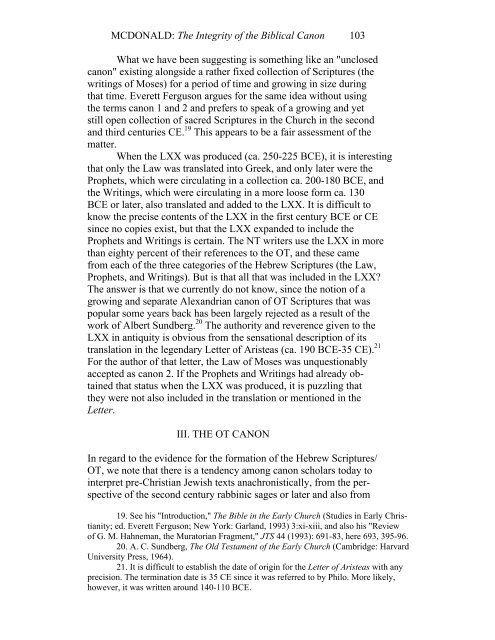The Integrity of the Biblical Canon in Light of Its Historical ...
The Integrity of the Biblical Canon in Light of Its Historical ...
The Integrity of the Biblical Canon in Light of Its Historical ...
Create successful ePaper yourself
Turn your PDF publications into a flip-book with our unique Google optimized e-Paper software.
MCDONALD: <strong>The</strong> <strong>Integrity</strong> <strong>of</strong> <strong>the</strong> <strong>Biblical</strong> <strong>Canon</strong> 103<br />
What we have been suggest<strong>in</strong>g is someth<strong>in</strong>g like an "unclosed<br />
canon" exist<strong>in</strong>g alongside a ra<strong>the</strong>r fixed collection <strong>of</strong> Scriptures (<strong>the</strong><br />
writ<strong>in</strong>gs <strong>of</strong> Moses) for a period <strong>of</strong> time and grow<strong>in</strong>g <strong>in</strong> size dur<strong>in</strong>g<br />
that time. Everett Ferguson argues for <strong>the</strong> same idea without us<strong>in</strong>g<br />
<strong>the</strong> terms canon 1 and 2 and prefers to speak <strong>of</strong> a grow<strong>in</strong>g and yet<br />
still open collection <strong>of</strong> sacred Scriptures <strong>in</strong> <strong>the</strong> Church <strong>in</strong> <strong>the</strong> second<br />
and third centuries CE. 19 This appears to be a fair assessment <strong>of</strong> <strong>the</strong><br />
matter.<br />
When <strong>the</strong> LXX was produced (ca. 250-225 BCE), it is <strong>in</strong>terest<strong>in</strong>g<br />
that only <strong>the</strong> Law was translated <strong>in</strong>to Greek, and only later were <strong>the</strong><br />
Prophets, which were circulat<strong>in</strong>g <strong>in</strong> a collection ca. 200-180 BCE, and<br />
<strong>the</strong> Writ<strong>in</strong>gs, which were circulat<strong>in</strong>g <strong>in</strong> a more loose form ca. 130<br />
BCE or later, also translated and added to <strong>the</strong> LXX. It is difficult to<br />
know <strong>the</strong> precise contents <strong>of</strong> <strong>the</strong> LXX <strong>in</strong> <strong>the</strong> first century BCE or CE<br />
s<strong>in</strong>ce no copies exist, but that <strong>the</strong> LXX expanded to <strong>in</strong>clude <strong>the</strong><br />
Prophets and Writ<strong>in</strong>gs is certa<strong>in</strong>. <strong>The</strong> NT writers use <strong>the</strong> LXX <strong>in</strong> more<br />
than eighty percent <strong>of</strong> <strong>the</strong>ir references to <strong>the</strong> OT, and <strong>the</strong>se came<br />
from each <strong>of</strong> <strong>the</strong> three categories <strong>of</strong> <strong>the</strong> Hebrew Scriptures (<strong>the</strong> Law,<br />
Prophets, and Writ<strong>in</strong>gs). But is that all that was <strong>in</strong>cluded <strong>in</strong> <strong>the</strong> LXX?<br />
<strong>The</strong> answer is that we currently do not know, s<strong>in</strong>ce <strong>the</strong> notion <strong>of</strong> a<br />
grow<strong>in</strong>g and separate Alexandrian canon <strong>of</strong> OT Scriptures that was<br />
popular some years back has been largely rejected as a result <strong>of</strong> <strong>the</strong><br />
work <strong>of</strong> Albert Sundberg. 20 <strong>The</strong> authority and reverence given to <strong>the</strong><br />
LXX <strong>in</strong> antiquity is obvious from <strong>the</strong> sensational description <strong>of</strong> its<br />
translation <strong>in</strong> <strong>the</strong> legendary Letter <strong>of</strong> Aristeas (ca. 190 BCE-35 CE). 21<br />
For <strong>the</strong> author <strong>of</strong> that letter, <strong>the</strong> Law <strong>of</strong> Moses was unquestionably<br />
accepted as canon 2. If <strong>the</strong> Prophets and Writ<strong>in</strong>gs had already obta<strong>in</strong>ed<br />
that status when <strong>the</strong> LXX was produced, it is puzzl<strong>in</strong>g that<br />
<strong>the</strong>y were not also <strong>in</strong>cluded <strong>in</strong> <strong>the</strong> translation or mentioned <strong>in</strong> <strong>the</strong><br />
Letter.<br />
III. THE OT CANON<br />
In regard to <strong>the</strong> evidence for <strong>the</strong> formation <strong>of</strong> <strong>the</strong> Hebrew Scriptures/<br />
OT, we note that <strong>the</strong>re is a tendency among canon scholars today to<br />
<strong>in</strong>terpret pre-Christian Jewish texts anachronistically, from <strong>the</strong> perspective<br />
<strong>of</strong> <strong>the</strong> second century rabb<strong>in</strong>ic sages or later and also from<br />
19. See his "Introduction," <strong>The</strong> Bible <strong>in</strong> <strong>the</strong> Early Church (Studies <strong>in</strong> Early Christianity;<br />
ed. Everett Ferguson; New York: Garland, 1993) 3:xi-xiii, and also his "Review<br />
<strong>of</strong> G. M. Hahneman, <strong>the</strong> Muratorian Fragment," JTS 44 (1993): 691-83, here 693, 395-96.<br />
20. A. C. Sundberg, <strong>The</strong> Old Testament <strong>of</strong> <strong>the</strong> Early Church (Cambridge: Harvard<br />
University Press, 1964).<br />
21. It is difficult to establish <strong>the</strong> date <strong>of</strong> orig<strong>in</strong> for <strong>the</strong> Letter <strong>of</strong> Aristeas with any<br />
precision. <strong>The</strong> term<strong>in</strong>ation date is 35 CE s<strong>in</strong>ce it was referred to by Philo. More likely,<br />
however, it was written around 140-110 BCE.
















